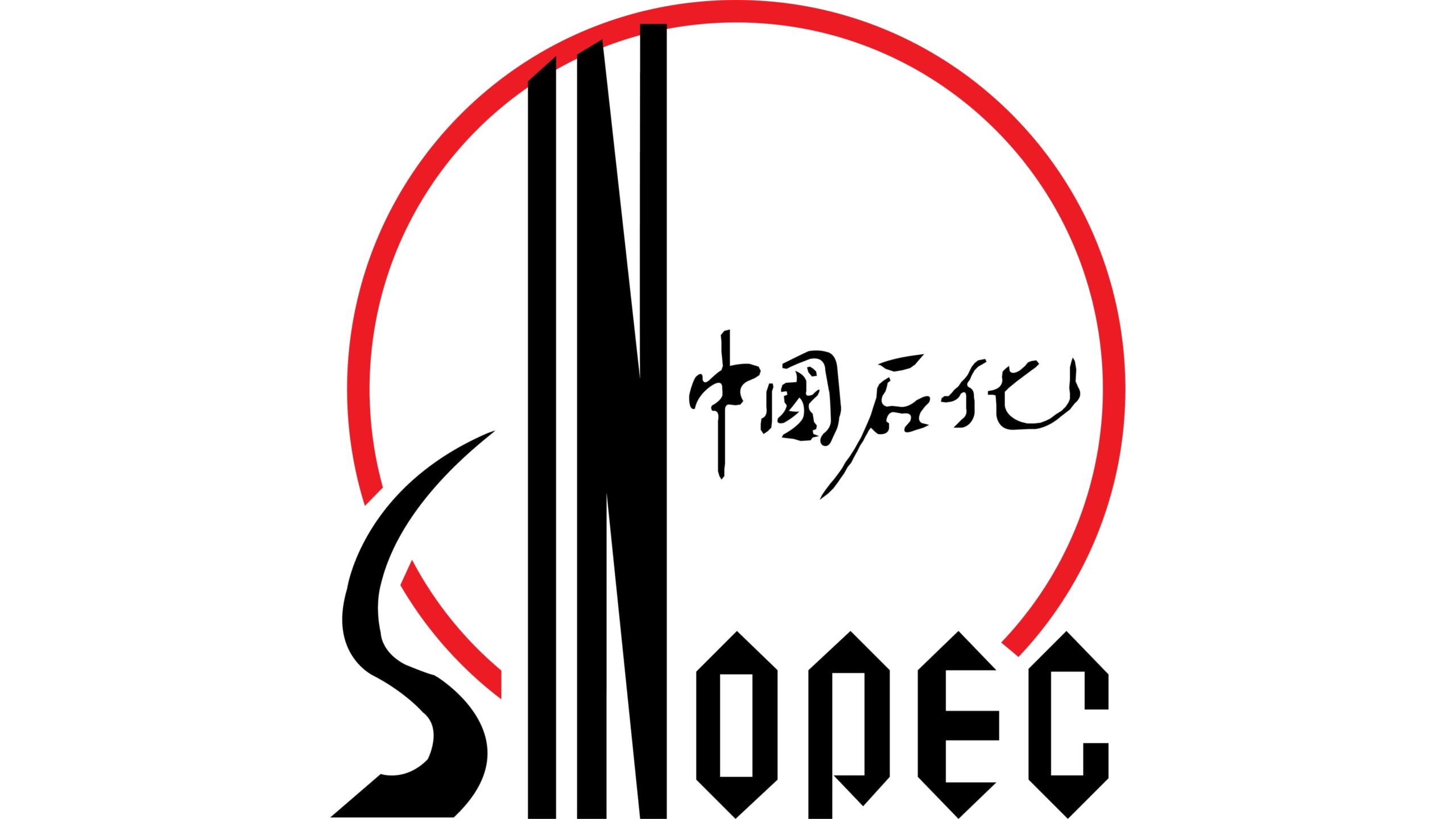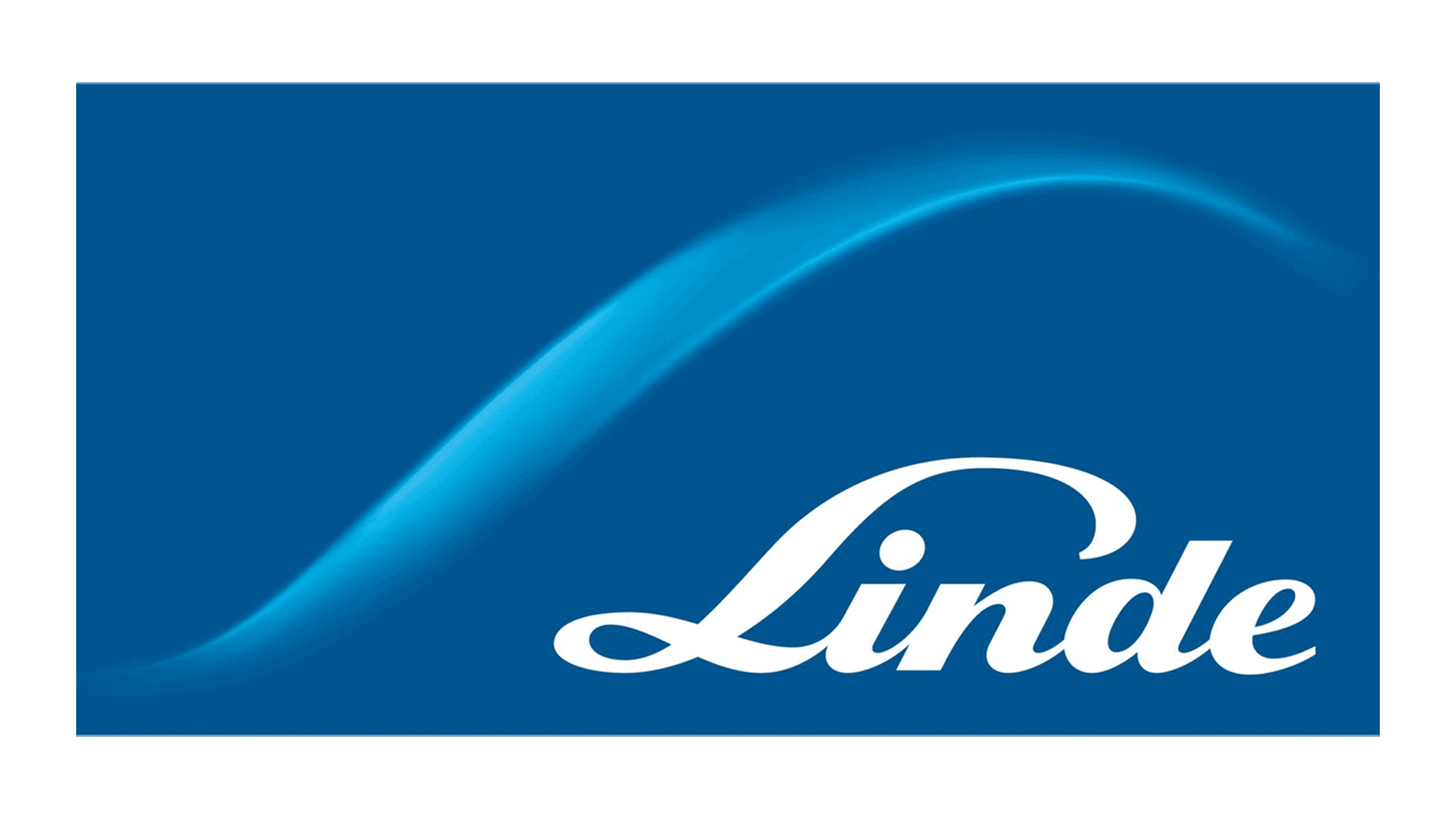Global Aroma Chemicals Market, By Source, By Application, By Type, By Form, By Region & Segmental Insights Trends and Forecast, 2024 – 2034
- Industry: Chemicals & Materials
- Report ID: TNR-110-1200
- Number of Pages: 420
- Table/Charts : Yes
- July, 2024
- Base Year : 2024
- No. of Companies : 10+
- No. of Countries : 29
- Views : 10254
- Covid Impact Covered: Yes
- War Impact Covered: Yes
- Formats : PDF, Excel, PPT
Aroma chemicals are synthetic or natural compounds used to impart specific fragrances or odors to various consumer products, including perfumes, cosmetics, toiletries, and household products. The global aroma chemicals market is experiencing robust growth driven by increasing consumer demand for personal care products and luxury fragrances. Key trends in the aroma chemicals market include a shift towards natural and sustainable ingredients, driven by consumer preference for eco-friendly products. This has led to innovations in bio-based aroma chemicals sourced from renewable materials. Additionally, technological advancements in fragrance encapsulation and delivery systems are enhancing product performance and longevity, further boosting market demand.
Opportunities in the market are abundant, particularly in emerging economies where rising disposable incomes are driving increased spending on personal grooming products. The growth driver for the aroma chemicals market lies in the expanding applications across diverse industries, including food and beverages, pharmaceuticals, and household cleaners. This diversification broadens the market base and reduces dependency on specific sectors, ensuring sustained growth and innovation in the industry. In Terms of Revenue, the Global Aroma Chemicals Market was Worth US$ 7.3 Bn in 2023, Anticipated to Witness CAGR of 8.1% During 2024 – 2034.

Trends in the Global Aroma Chemicals Market
- Shift Towards Natural and Sustainable Ingredients: This shift is driven by increasing awareness of environmental sustainability and health consciousness among consumers. Manufacturers are responding by developing bio-based aroma chemicals sourced from renewable materials such as plants and organic compounds. This trend not only aligns with regulatory pressures for cleaner production processes but also caters to the rising demand for eco-friendly products across various industries. As companies invest in research and development of sustainable alternatives, the market is poised to witness continued growth in this segment, offering opportunities for innovation and differentiation.
- Technological Advancements in Fragrance Delivery Systems: Innovations in encapsulation technologies and controlled-release mechanisms are enhancing the longevity and performance of fragrances in consumer products. These advancements address consumer expectations for longer-lasting and more impactful scents, especially in perfumes, air fresheners, and personal care items. By improving the stability and efficacy of aroma chemicals, manufacturers can differentiate their products in a competitive market landscape. This trend also supports the development of customizable and multifunctional fragrance solutions, catering to diverse consumer preferences and application requirements across global markets.
Synthetic by source category has emerged as a dominant segment in the global aroma chemicals market as synthetic chemicals offer consistency in quality and fragrance profile, which is crucial for maintaining product standards and meeting consumer expectations across various industries.
Manufacturers can precisely control the composition and characteristics of synthetic aroma chemicals, ensuring reliability in formulations and reducing production variability compared to natural counterparts. Synthetic aroma chemicals often provide cost advantages over natural alternatives, making them more accessible for mass production and widespread adoption in consumer goods. This cost-effectiveness allows manufacturers to achieve competitive pricing strategies while maintaining profitability. Advancements in synthetic chemistry have enabled the development of new fragrance molecules that replicate or enhance natural scents, driving innovation and expanding application possibilities in perfumery, cosmetics, and household products. As consumer demand for diverse and long-lasting fragrances grows, the synthetic segment continues to play a pivotal role in shaping the aroma chemicals market globally.
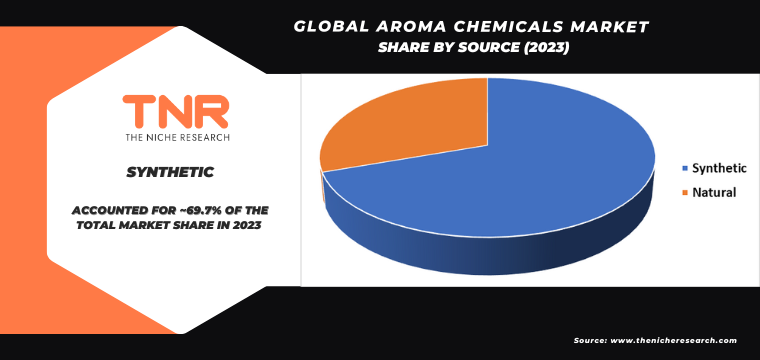
In 2023, the flavors segment solidified its position as the second-largest category within the global aroma chemicals market.
There has been an increasing consumer demand for enhanced sensory experiences in food and beverage products, driving the need for diverse and appealing flavors. Aroma chemicals play a pivotal role in achieving these flavors by imparting specific taste profiles and enhancing product palatability. Technological advancements in flavour encapsulation and delivery systems have expanded the application scope of aroma chemicals in food processing, ensuring consistent taste and aroma over extended shelf-life periods.
This reliability is crucial for manufacturers seeking to meet stringent quality standards and regulatory requirements globally. The flavors segment benefits from ongoing innovations in natural and synthetic flavour compounds, catering to shifting consumer preferences towards healthier, cleaner label products without compromising on taste or sensory appeal. As such, the flavour segment continues to grow robustly, driving market expansion and innovation in the aroma chemicals industry.
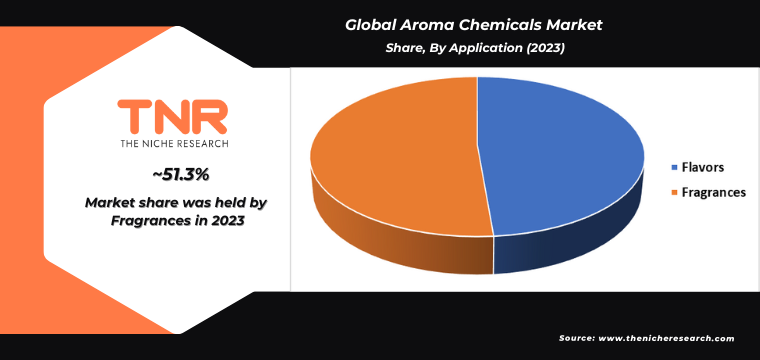
Terpenes segment, categorized by type, has exerted significant dominance over the global aroma chemicals market.
Terpenes are naturally occurring compounds found in plants, known for their distinct aromatic profiles and therapeutic benefits. They play a crucial role in various industries, including cosmetics, pharmaceuticals, and food and beverages. One key factor contributing to the dominance of the terpenes segment is the increasing consumer preference for natural and organic products. Terpenes are often sourced from botanical sources such as citrus fruits, pine trees, and cannabis, aligning with the growing demand for natural ingredients in consumer goods.
Their natural origin also appeals to health-conscious consumers seeking products with minimal synthetic additives. The diverse range of terpene types, each with unique fragrance and therapeutic properties, allows for broad applications in fragrance blends, essential oils, medicinal formulations, and flavour enhancers. As research continues to uncover new benefits and applications, the terpenes segment is poised for continued growth and innovation in the aroma chemicals market.
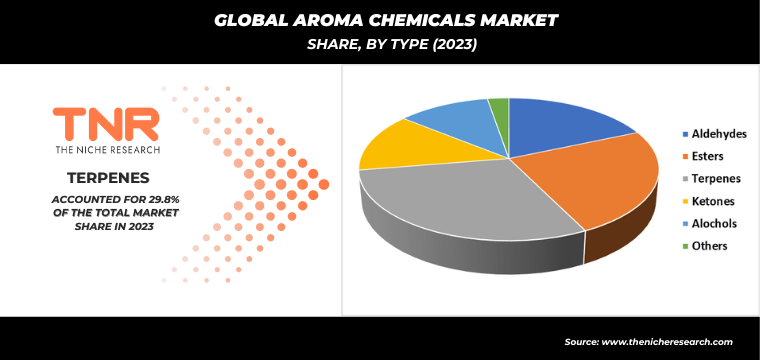
By form, dry segment is anticipated to grow fastest over the forecast timeline in global aroma chemicals market.
Dry aroma chemicals offer distinct advantages in terms of handling, storage, and transportation efficiency compared to liquid or oil-based counterparts. This makes them particularly appealing for industries requiring stable and easy-to-use ingredients, such as food processing, cosmetics manufacturing, and household products. Advancements in spray drying and powder encapsulation technologies have enhanced the stability and shelf life of dry aroma chemicals, contributing to their increasing adoption.
These technologies allow for precise control over particle size and dispersibility, ensuring consistent fragrance release and performance in various applications. The preference for dry aroma chemicals aligns with trends towards convenience and sustainability in product formulations, as they often require fewer preservatives and packaging materials compared to liquid forms. As such, the dry segment is expected to capture significant market share and drive innovation in the aroma chemicals industry.
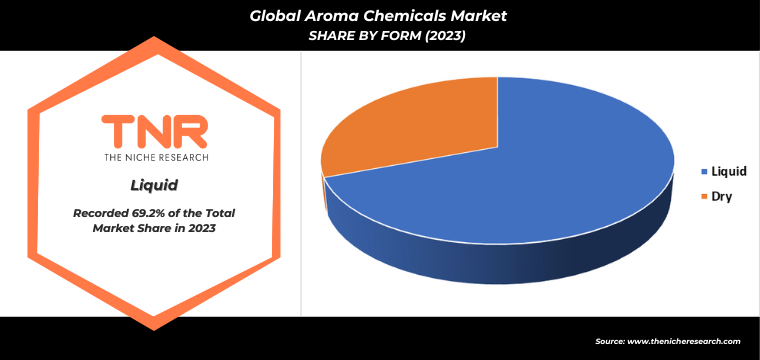
In 2023, Asia Pacific solidified its dominance in the global aroma chemicals market, contributing a revenue share of 31.9%.
This dominance can be attributed to several key factors. Firstly, the region’s burgeoning population and rising disposable incomes have fuelled demand for personal care products, cosmetics, and luxury fragrances, driving the consumption of aroma chemicals. Asia Pacific hosts a significant portion of the global manufacturing base for fragrance and flavours industries, leveraging cost-effective production capabilities and access to raw materials.
This manufacturing advantage allows companies in the region to cater to both domestic and international markets efficiently. Favourable government policies, increasing investments in research and development, and a growing trend towards natural and sustainable ingredients have further bolstered the aroma chemicals market in Asia Pacific. As the region continues to expand economically and culturally, it is poised to maintain its pivotal role in shaping the global aroma chemicals industry.
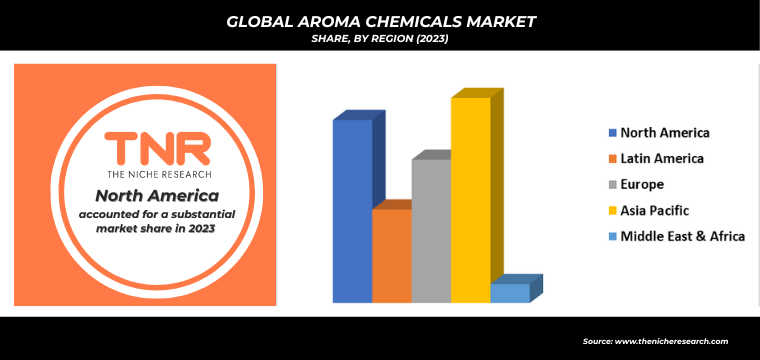
Competitive Landscape
Some of the players operating in the aroma chemicals market are
- BASF SE
- Bell Flowers & Fragrances
- BORDAS S.A.
- Givaudan
- Kao Corporation
- Privi Organics India Limited
- S H Kelkar and Company
- Symrise
- Takasago International Corporation
- Other Industry Participants
Global Aroma Chemicals Market Scope
| Report Specifications | Details |
| Market Revenue in 2023 | US$ 7.3 Bn |
| Market Size Forecast by 2034 | US$ 12.6 Bn |
| Growth Rate (CAGR) | 5.1% |
| Historic Data | 2016 – 2022 |
| Base Year for Estimation | 2023 |
| Forecast Period | 2024 – 2034 |
| Report Inclusions | Market Size & Estimates, Market Dynamics, Competitive Scenario, Trends, Growth Factors, Market Determinants, Key Investment Segmentation, Product/Service/Solutions Benchmarking |
| Segments Covered | By Source, By Application, By Type, By Form, By Region |
| Regions Covered | North America, Europe, Asia Pacific, Middle East & Africa, Latin America |
| Countries Covered | U.S., Canada, Mexico, Rest of North America, France, The UK, Spain, Germany, Italy, Nordic Countries (Denmark, Finland, Iceland, Sweden, Norway), Benelux Union (Belgium, The Netherlands, Luxembourg), Rest of Europe, China, Japan, India, New Zealand, Australia, South Korea, Southeast Asia (Indonesia, Thailand, Malaysia, Singapore, Rest of Southeast Asia), Rest of Asia Pacific, Saudi Arabia, UAE, Egypt, Kuwait, South Africa, Rest of Middle East & Africa, Brazil, Argentina, Rest of Latin America |
| Key Players | BASF SE, Bell Flowers & Fragrances, BORDAS S.A., Givaudan, Kao Corporation, Privi Organics India Limited, S H Kelkar and Company, Symrise, Takasago International Corporation |
| Customization Scope | Customization allows for the inclusion/modification of content pertaining to geographical regions, countries, and specific market segments. |
| Pricing & Procurement Options | Explore purchase options tailored to your specific research requirements |
| Contact Details | Consult With Our Expert
Japan (Toll-Free): +81 663-386-8111 South Korea (Toll-Free): +82-808- 703-126 Saudi Arabia (Toll-Free): +966 800-850-1643 United Kingdom: +44 753-710-5080 United States: +1 302-232-5106 E-mail: askanexpert@thenicheresearch.com
|
Global Aroma Chemicals Market
By Source
- Synthetic
- Natural
By Application
- Flavors
- Confectionery
- Convenience Food
- Bakery Food
- Dairy Products
- Beverages
- Others
- Fragrances
- Fine Fragrance
- Cosmetics and Toiletries
- Soaps and Detergents
- Others
By Type
- Aldehydes
- Esters
- Terpenes
- Ketones
- Alcohols
- Others
By Form
- Liquid
- Dry
By Region
- North America (U.S., Canada, Mexico, Rest of North America)
- Europe (France, The UK, Spain, Germany, Italy, Nordic Countries (Denmark, Finland, Iceland, Sweden, Norway), Benelux Union (Belgium, The Netherlands, Luxembourg), Rest of Europe)
- Asia Pacific (China, Japan, India, New Zealand, Australia, South Korea, Southeast Asia (Indonesia, Thailand, Malaysia, Singapore, Rest of Southeast Asia), Rest of Asia Pacific)
- Middle East & Africa (Saudi Arabia, UAE, Egypt, Kuwait, South Africa, Rest of Middle East & Africa)
- Latin America (Brazil, Argentina, Rest of Latin America)
Report Layout:
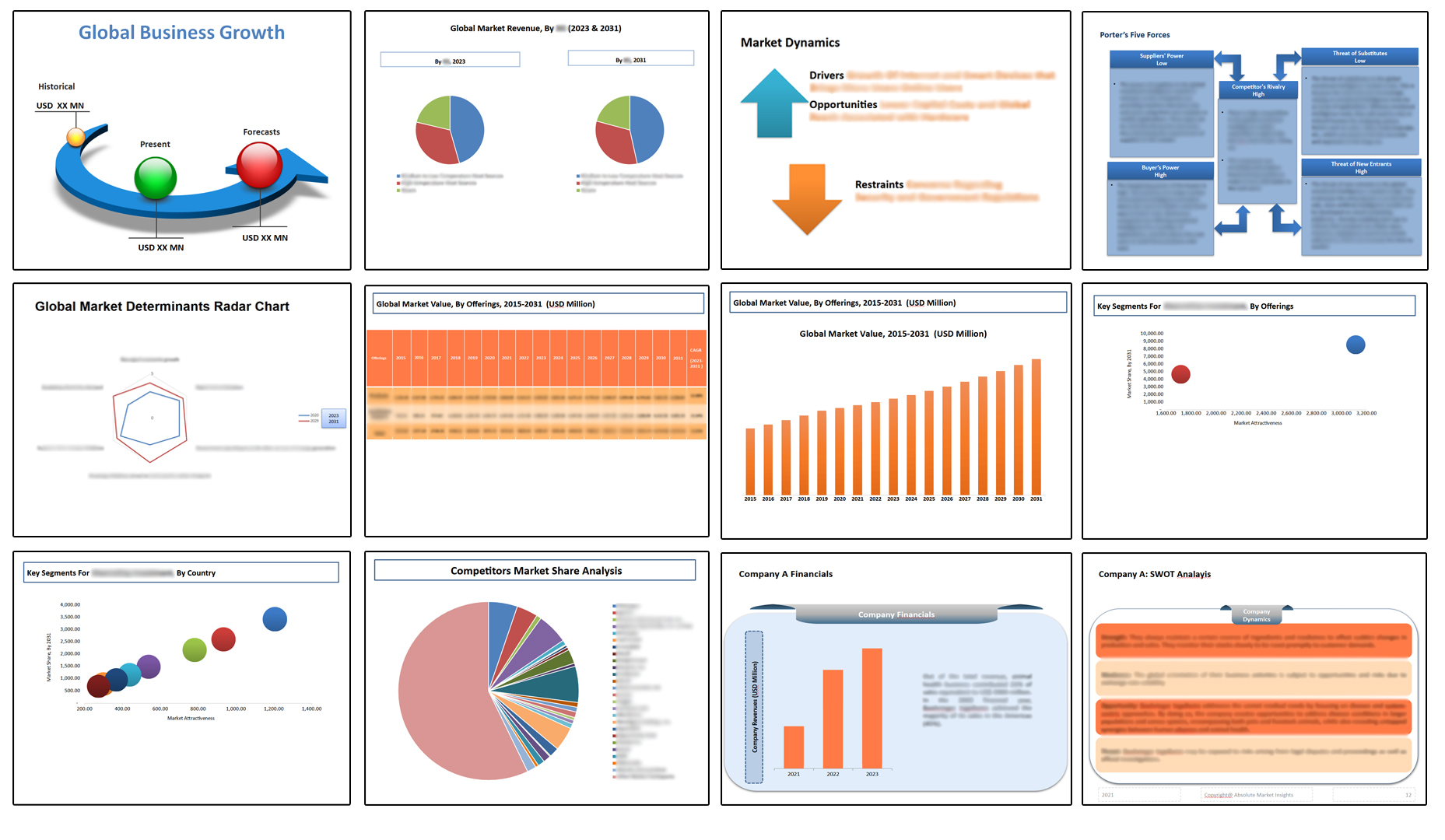
Table of Contents
Note: This ToC is tentative and can be changed according to the research study conducted during the course of report completion.
**Exclusive for Multi-User and Enterprise User.
Global Aroma Chemicals Market
By Source
- Synthetic
- Natural
By Application
- Flavors
- Confectionery
- Convenience Food
- Bakery Food
- Dairy Products
- Beverages
- Others
- Fragrances
- Fine Fragrance
- Cosmetics and Toiletries
- Soaps and Detergents
- Others
By Type
- Aldehydes
- Esters
- Terpenes
- Ketones
- Alcohols
- Others
By Form
- Liquid
- Dry
By Region
- North America (U.S., Canada, Mexico, Rest of North America)
- Europe (France, The UK, Spain, Germany, Italy, Nordic Countries (Denmark, Finland, Iceland, Sweden, Norway), Benelux Union (Belgium, The Netherlands, Luxembourg), Rest of Europe)
- Asia Pacific (China, Japan, India, New Zealand, Australia, South Korea, Southeast Asia (Indonesia, Thailand, Malaysia, Singapore, Rest of Southeast Asia), Rest of Asia Pacific)
- Middle East & Africa (Saudi Arabia, UAE, Egypt, Kuwait, South Africa, Rest of Middle East & Africa)
- Latin America (Brazil, Argentina, Rest of Latin America)
The Niche Research approach encompasses both primary and secondary research methods to provide comprehensive insights. While primary research is the cornerstone of our studies, we also incorporate secondary research sources such as company annual reports, premium industry databases, press releases, industry journals, and white papers.
Within our primary research, we actively engage with various industry stakeholders, conducting paid interviews and surveys. Our meticulous analysis extends to every market participant in major countries, allowing us to thoroughly examine their portfolios, calculate market shares, and segment revenues.
Our data collection primarily focuses on individual countries within our research scope, enabling us to estimate regional market sizes. Typically, we employ a bottom-up approach, meticulously tracking trends in different countries. We analyze growth drivers, constraints, technological innovations, and opportunities for each country, ultimately arriving at regional figures.Our process begins by examining the growth prospects of each country. Building upon these insights, we project growth and trends for the entire region. Finally, we utilize our proprietary model to refine estimations and forecasts.
Our data validation standards are integral to ensuring the reliability and accuracy of our research findings. Here’s a breakdown of our data validation processes and the stakeholders we engage with during our primary research:
- Supply Side Analysis: We initiate a supply side analysis by directly contacting market participants, through telephonic interviews and questionnaires containing both open-ended and close-ended questions. We gather information on their portfolios, segment revenues, developments, and growth strategies.
- Demand Side Analysis: To gain insights into adoption trends and consumer preferences, we reach out to target customers and users (non-vendors). This information forms a vital part of the qualitative analysis section of our reports, covering market dynamics, adoption trends, consumer behavior, spending patterns, and other related aspects.
- Consultant Insights: We tap into the expertise of our partner consultants from around the world to obtain their unique viewpoints and perspectives. Their insights contribute to a well-rounded understanding of the markets under investigation.
- In-House Validation: To ensure data accuracy and reliability, we conduct cross-validation of data points and information through our in-house team of consultants and utilize advanced data modeling tools for thorough verification.
The forecasts we provide are based on a comprehensive assessment of various factors, including:
- Market Trends and Past Performance (Last Five Years): We accurately analyze market trends and performance data from preceding five years to identify historical patterns and understand the market’s evolution.
- Historical Performance and Growth of Market Participants: We assess the historical performance and growth trajectories of key market participants. This analysis provides insights into the competitive landscape and individual company strategies.
- Market Determinants Impact Analysis (Next Eight Years): We conduct a rigorous analysis of the factors that are projected to influence the market over the next eight years. This includes assessing both internal and external determinants that can shape market dynamics.
- Drivers and Challenges for the Forecast Period:Identify the factors expected to drive market growth during the forecast period, as well as the challenges that the industry may face. This analysis aids in deriving an accurate growth rate projection.
- New Acquisitions, Collaborations, or Partnerships: We keep a close watch on any new acquisitions, collaborations, or partnerships within the industry. These developments can have a significant impact on market dynamics and competitiveness.
- Macro and Micro Factors Analysis:A thorough examination of both macro-level factors (e.g., economic trends, regulatory changes) and micro-level factors (e.g., technological advancements, consumer preferences) that may influence the market during the forecast period.
- End-User Sentiment Analysis: To understand the market from the end-user perspective, we conduct sentiment analysis. This involves assessing the sentiment, preferences, and feedback of the end-users, which can provide valuable insights into market trends.
- Perspective of Primary Participants: Insights gathered directly from primary research participants play a crucial role in shaping our forecasts. Their perspectives and experiences provide valuable qualitative data.
- Year-on-Year Growth Trend: We utilize a year-on-year growth trend based on historical market growth and expected future trends. This helps in formulating our growth projections, aligning them with the market’s historical performance.
Research process adopted by TNR involves multiple stages, including data collection, validation, quality checks, and presentation. It’s crucial that the data and information we provide add value to your existing market understanding and expertise. We have also established partnerships with business consulting, research, and survey organizations across regions and globally to collaborate on regional analysis and data validation, ensuring the highest level of accuracy and reliability in our reports.


